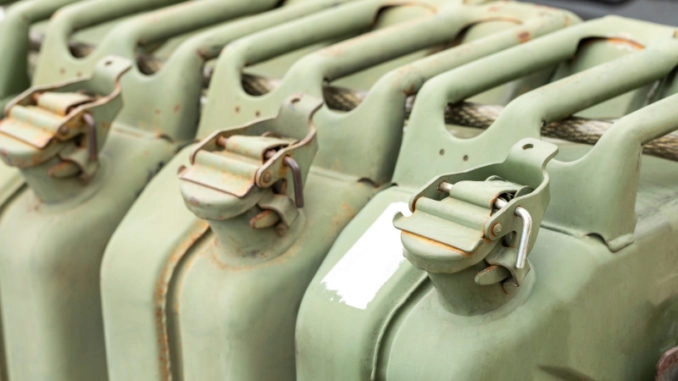
An essential tool today for long journeys by car, the jerrycan was above all developed during the Second World War to meet the practical needs of soldiers. You had to think about refueling from time to time, and in wartime, impossible to detour by the nearest service station.
The jerrycan, a German invention.
The jerrycan, more often called a gasoline canister, is a container for fuel. Its history begins in 1937. This steel model was invented by the Germans who then intensively developed their military equipment. The simplest solution for refueling vehicles seems obvious: they have to take a supply of gas with them.

Supply
It is the action of bringing provisions in food, fuel and other necessary products.
The Germans called this container “kanister”. To meet the soldiers’ needs, it had to be as practical as possible. Thus, it must have a capacity of 20 liters and weigh around twenty kilograms, be easily portable by a single man, of size facilitating transport and storage in a minimum of volume, be provided with handles facilitating its transfer and finally be produced through simple and inexpensive manufacturing processes.

Wehrmacht-Einheitskanister (jerrican), fixed on a Kübelwagen from the Feldgendarmerie (Russia, 1943).
Credential : Bundesarchiv Bild 101I-022-2926-07, Russland, Unternehmen “Zitadelle”, VW Kübelwagen.jpg

Panzers transporting several jerrycans on the parcel shelf (Russia, summer 1941).
Credentials : Bundesarchiv Bild 101I-265-0040A-22A, Russland, Panzer IV und Panzer II.jpg
The first models of this square canister were then produced in large quantities, in the greatest secrecy, by the firms Müller and ABP from 1937. They quickly equipped the troops using vehicles and tanks of the German army. This army is called Wehrmacht.
The Allies, in other words, the French, the Belgians, the English, and the Americans, discovered this “kanister” from the start of the war in 1940. Practically, it was quickly copied and adopted by all the other countries at war. On June 6, 1944, during the Normandy landings, the Allies used some 17 million copies.
From kanister to jerry can, what has changed?
Before using the Kanister, the Americans used cylindrical canisters of 5, 10 or 55 US gallons (19, 38 or 208 L). We immediately understand that these canisters are not very easy to handle and store. This is why the Americans also adopted this “kanister” which they produced in 1941. They baptized it “jerrycan”, the contraction of “jerry”, a mocking nickname given by English speakers to German soldiers, and “can” meaning container. However, to make them more effective, they modify their shape. The American version of the German canister is made from a simple folded sheet then welded, forming the body, on which are welded the flat bottom and a cap. This headdress is composed of 3 handles to facilitate transport. It also has a screw cap whose size corresponds to that of the petroleum sector. This allows them to use a dispenser noozle.


How do I know what jerry cans contain?
To differentiate transported liquids, metal medallions are securely attached to the handles. Their colors and the inscriptions in relief, recognizable at night without lighting, informed about the nature of the liquid. Soldiers could distinguish the essence from kerosene, diesel or oil and the properties of these liquids. The jerrycans used only for the transport of drinking water are recognizable by the cross made with white paint on their sides.


The use of jerrycan after the War...
At the end of the war, the production of the jerrycan will obviously continue.
This invention is so interesting that petroleum distributors will buy large quantities in excess from the military to market their products. Of course, these canisters will be repainted in the colors of the oil company. But, the jerrycan will also begin to be widely used by the individuals who recovered it in quantity at the side of the roads, abandoned by the soldiers after the fighting.
More than 80 years after its conception, all the armies around the world use this same fuel container to equip their vehicles. And this one has hardly changed shape.
In popular culture, it has also become the essential accessory for camping, as the essential companion in a vehicle in the event of a breakdown. He even entered the collective imagination. Remember: in “Tintin in the Land of Black Gold”, the mythical brothers Dupond and Dupont get lost with their Jeep in a terrible sandstorm. They then lose their jerrycan, which they find a little later, because they are going into circles …



